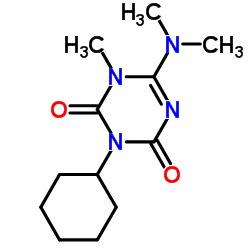Degradation and metabolism of hexazinone by two isolated bacterial strains from soil.
Xuedong Wang, Huili Wang, Chengxia Tan
Index: Chemosphere 61(10) , 1468-74, (2005)
Full Text: HTML
Abstract
Two hexazinone-degrading bacterial strains were isolated from soil by enrichment culture technique, and identified as Pseudomonas sp. and Enterobacter cloacap. The two purified isolates, designated as WFX-1 and WFX-2, could rapidly degrade hexazinone with a half-life of 3.08 days and 2.95 days in mineral salt medium (MSM), while their mixed bacterial culture was found to degrade hexazinone, at an initial concentration of 50 microg/ml, by enhancing 2.3-fold over that when the isolates were used alone. Two microbial metabolites (A and D) were obtained by preparative TLC and identified on the basis of the spectral data of IR, 1H NMR and HPLC-ESI-MS, but both of them were known products as they had been reported in soil and vegetation metabolites of hexazinone. However, metabolites B and C were new degradates, whose molecular weights (MW) were 157 and 156, respectively, being reported from microbial metabolism for the first time.
Related Compounds
| Structure | Name/CAS No. | Molecular Formula | Articles |
|---|---|---|---|
 |
Hexazinone
CAS:51235-04-2 |
C12H20N4O2 |
|
The interaction between natural organic matter in raw waters...
2013-01-01 [Water Sci. Technol. 67(11) , 2428-36, (2013)] |
|
Dissipation of four forest-use herbicides at high latitudes.
2008-10-01 [Environ. Sci. Pollut. Res. Int. 15(7) , 573-83, (2008)] |
|
Comparison between the short-term and the long-term toxicity...
2009-01-01 [Water Res. 43(6) , 1731-9, (2009)] |
|
Combined photobacterium toxicity of herbicide mixtures conta...
2009-04-01 [Chemosphere 75(3) , 381-8, (2009)] |
|
Impacts of stage-specific acute pesticide exposure on predic...
2010-07-01 [Aquat. Toxicol. 98(3) , 265-74, (2010)] |